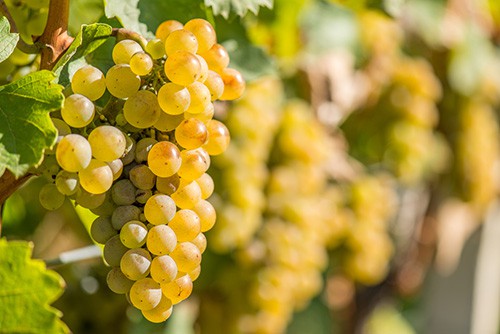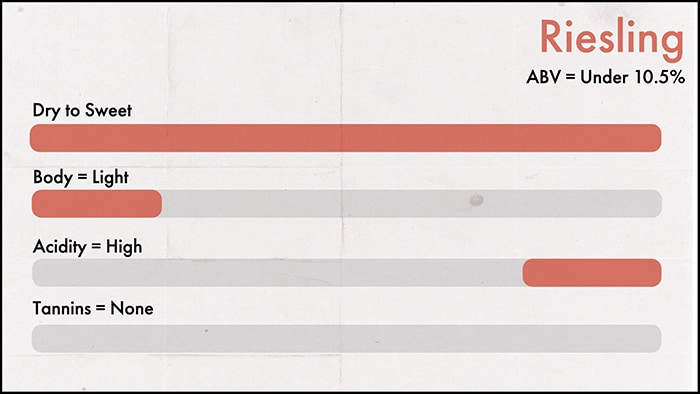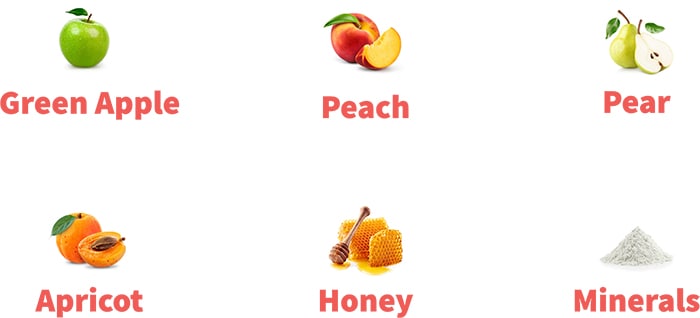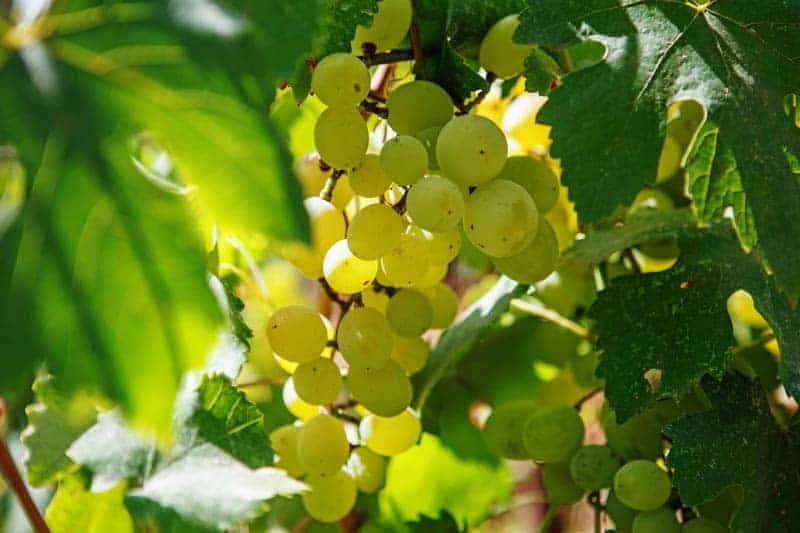Complete Guide to Riesling Wine | Wine 101

There are over 2,100 castles and 1,500 different beers in Germany, yet these pale in comparison to the versatility of Riesling.
Riesling is Germany's most successful wine grape, capable of producing wines in all styles, from bone dry to sparkling and sickly sweet.
Although Riesling is much-loved by wine connoisseurs, people overlook it on the shelf in favor of mainstream varietals like Sauvignon Blanc - a crying shame because it offers a treat outside the mainstream wine world.
A good Riesling is distinctly floral with intense notes of apple, apricot, peach, and pear – a top choice if you enjoy fruity, light wines.
Read our guide to Riesling wine below to discover everything you need to know, including tasting notes, history, the notable Riesling wine regions, and a background on the grapes.
Characteristics of Riesling

Riesling is one of the only grapes that can produce bone-dry and tingly-tart wines alongside sweet dessert wines.
Characteristics vary depending on the dry scale, and there are regional differences too.
Here's a breakdown of what to expect:
- Sweet Riesling: Golden-yellow with moderate acidity, fruity-floral flavors, intense sweetness, and tropical fruit aromas.
- Semi-sweet Riesling: Pale golden-yellow with high acidity and intense flowery flavors with apple, peach, and honeydew aromas.
- Dry Riesling: Pale straw-yellow with high acidity, bold apple, apricot, peach, and pear notes, and a floral nose.
German Riesling has a fuller body than other regions, with pronounced acidity and relatively low ABV (usually under 10.5% ABV).
Washington/Oregon Riesling has more tropical flavors, while Alsatian (French) Riesling has more floral notes.
Whichever Riesling you pick up, you can expect bold acidity, a floral bouquet, and minerality from the early season and cold region varieties.
Riesling Tasting Notes

Riesling is intensely fruity with apricot, peach, pineapple, pear, lemon, lime, guava, and Granny Smith apple flavors. The colder the grape's climate, the more prominent the green fruit notes like apple and pear.
The thing that makes Riesling so special is the floral bouquet and palate, with white flowers, stone fruit, blossom, and subtle bark notes.
With extended aging, Riesling varieties also take on petrol notes – a by-product of the compound 1,1,6,-trimethyl-1,2-dihydro naphthalene (TDN), which is unusually high in the grape and activated with acid hydrolysis.
However, while these flavors and aromas are typical across all Riesling varietals, the wine's dryness largely defines its taste profile.
As discussed above, Riesling ranges from sweet dessert to bone dry. Sweet varietals are heavy on peach, pineapple, lime, and apricot, while dry varieties have a tart twang with lashings of lemon, green apple, and guava.
You can also find Gewurztraminer – Riesling, and Chardonnay – Riesling blends, which dial down the tropical or green fruit notes.
Gewurztraminer is a terrific pairing, bringing notes of honey, rose, lychee, and orange to the table.



How is Riesling Served?
Riesling is best served very cold at 38–45°F / 3-7°C. The cold temperature brings out the fruity flavors and subdues some acidity, helping sweetness shine through. As you go up in temperature, you can expect more acidity.
There's no need to decant Riesling, but it does benefit from a few minutes in the glass before tasting. You can serve it in any standard wine glass.
Dry Riesling works as a sipping wine, with sweet versions suitable as a dessert or as a pairing to creamy and fruity desserts.
The Riesling Grape

The Riesling grape originates from the Rhine River region of Germany, which runs through Germany, Austria, France, and Switzerland.
We can trace the grape's history to 1435 when Count John IV of Katzenelnbogen purchased six "Riesslingen" vines in Rüsselsheim.
The grape became "Riesling" in 1552 when German botanist Hieronymus Bock began transitioning from medieval botany to modern scientific botany.
Riesling's ability to thrive in cold climates meant it spread across much of Germany, especially the river valleys, replacing several lesser vines.
The grape is mentioned in French texts as early as 1477, when it was planted in Alsace, France's largest Riesling-producing region.
Riesling cuttings were exported to Australia in the 1830s, the second largest producer of Riesling wine after Germany and ahead of France.
Like its German counterpart, Gewurztraminer, Riesling enjoys a left-field position in the wine world, chosen mainly by those in the know. And we're okay with that because Riesling is so good that we want it all for ourselves!
Notable Regions for Riesling
The great Riesling of the world is still very much associated with its traditional Old World home, but there are lovely New World expressions popping up now too.
Mosel Valley, Germany
The Mosel Valley is home to the Mosel River, and along this winding river gorge, you'll find the home of Riesling. Mosel has thirteen wine regions - Bernkastel is the most planted region, followed by Saar and Ruwertal.
The typical German Riesling has pronounced acidity, strong fruity flavors bordering on tropical, and a subtle undertone of grass.
Alsace, France
Riesling was planted in Alsace in 1477, where it flourished. For much of its history, Alsace was part of Germany, becoming a part of France in 1918 when Alsace was ceded to France under the Treaty of Versailles.
The moderate climate of Alsace produces Riesling rich with lime, Meyer Lemon, and apricot notes, dialing down the tropical edge.
Austria
Historical records show that Riesling grew in Austria from 1526, but it could have grown there since the late 1400s. Austria has 2,000 hectares of Riesling, mainly producing sweet wines in the dessert wine category.
The mineral soils in Austria produce a unique Riesling wine with notes of stone fruit, peach, flowers, and pear.
Clare & Eden Valleys, South Australia
South Australia's warm, arid climate might appear unsuitable for Riesling. Still, it thrives in the Clare and Eden Valleys, which have brisk nights and cooler daytime temperatures than the bordering Barossa Valley.
South Australian Riesling is an excellent choice. It is usually bone dry with a chalky quality, bright fruit, and delicate floral notes.
Riesling Food Pairings
We love Riesling as a sipping wine when it's dry or semi-sweet, with semi-sweet varieties scratching that itch for something sweet but not sickly. Dry varieties are super-refreshing, so they go down a treat on a hot summer's day.
If you intend to pair Riesling with food, the best matchings depend on the sweetness and the region. Here's what we recommend:
- Sweet Riesling: Asian spices, fresh fruit, creamy desserts, fruity desserts, jam.
- Semi-dry Riesling: Duck, pork, bacon, soft cheeses, nachos, Thai beef salad, satay chicken, grilled shrimp, pate.
- Dry Riesling: Cheese tarts, Pad Thai, seafood, shellfish, sole, chicken, pasta in white sauce, garlic, and herby dishes.
In summary - pair sweet with sugar and spice and tart with garlic and herbs.
Riesling’s lime and citrus flavors are also great with smoked fish, cured meats, grilled sausages, and dishes with smoked paprika.
Tropical Riesling is best with Thai and Szechuan cuisine, where bold chilis and spices work to enhance the guava and passionfruit notes.
3 Great Riesling Wines to Try
If your interest in Riesling wine has been piqued you should try one of these amazing expressions next!
1. Under $15 - Chateau Ste. Michelle Columbia Valley Riesling 2020

The Chateau Ste. Michelle Valley Riesling is a refreshing, off-dry wine with intense lime, lemon, and peach notes. It's big on tree fruit and offers a chalky quality on the finish, with pear, apple, and melon undertones.
Try this wine with brie, duck liver pate, grilled fish, and spicy Asian cuisine. It also goes well with fruit compote and pastries.
Note: They do a dry version too which is equally good!
Don't miss our guide on great, affordable Riesling wine for some more tips!
2. Under $30 - Donnhoff Oberhauser Leistenberg Riesling Kabinett 2021

This is a pure expression of German Riesling, with bright peach, citrus, and honeydew aromas and flavors. A hint of orange peel gives it a fresh, youthful personality. It's sweet, with white flowers and slate on the finish.
Szechuan and Cajun food go beautifully with this sweet wine, or you can try it with beef tacos to bring out the best in salty, spicy beef.
3. Under $100 - Dr. Loosen Wehlener Sonnenuhr Alte Reben Riesling Grosses Gewachs Reserve 2014

Dr. Loosen Wehlener Sonnenuhr Alte Reben Riesling is the best you can get for under $100, with intense peach, lime, and tropical flavors. It's dry, with crisp acidity and a great structure to refresh your palate.
Grilled white fish, lobster, crab, scallops, sushi, Thai beef salad, pink duck, pork chops, and chicken dishes go well with this wine.
3 Interesting Facts About Riesling
1. Riesling is one of the oldest grape varieties in the world
The Riesling grape originates from the Rhine River region of Germany. Although first mentioned in historical texts in 1435 as "Riesslingen," it is widely believed to have grown across the Rhine River centuries before this. For context, Sauvignon Blanc's first historical mention was in the 1500s.
2. The Riesling vine thrives in cool climate growing zones
Riesling vines thrive in cool to intermediate climates due to thicker bark, which resists snow, ice, and frost damage.
Additionally, Riesling is an early-ripening grape, so cool climates prevent over-ripening. Warm climate, late-ripening Riesling also exists, with these wines having a softer, less acidic profile.
3. Riesling is grown in every key wine-producing region
Riesling is grown in Germany, Austria, France, the US, Australia, New Zealand, California, South Africa, Canada, Croatia, and many more countries.
Although Riesling isn't the world's most planted wine grape (that award goes to the red grape Cabernet Sauvignon), it takes up the commendable 20th spot with around 120,000 acres.
